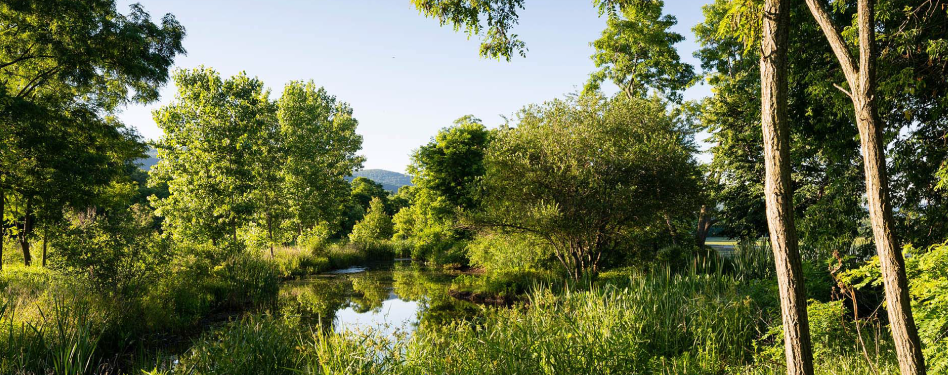
Green infrastructure is increasingly used to address climate impact issues, such as stormwater runoff, and to provide myriad benefits to a community. The SITES Rating System facilitates green infrastructure planning to create beautiful outdoor spaces that are functional and resilient.
What is green infrastructure?
Green infrastructure refers to the use or replication of natural systems to achieve a desired outcome, such as improving water quality, reducing runoff, mitigating urban heat island effects or providing access to more vegetation in an increasingly urban world. This is accomplished through strategies such as vegetated roofs, rain gardens, bioswales or pervious pavement.
Green infrastructure practices can complement or decrease reliance on traditional stormwater technologies or grey infrastructure (e.g., pipes, pumps, ditches), which typically serve the single purpose of moving water away from a site as quickly as possible. In green infrastructure and in SITES, water is viewed as a precious limited resource and considered an opportunity to address multiple issues and goals.
Many cities look at green infrastructure as a strategy to prevent damage and pollution caused by stormwater runoff, particularly in areas with combined sewer overflows. This approach to site design can protect coastal communities from storms and flooding.
Working with nature
Consider the SITES-certified Long Dock Park and its exemplary approach to working with nature. Located on the Hudson River in Beacon, New York, this 14-acre brownfield redevelopment not only returned access to the river for the local community, but it was also designed to be resilient, knowing that future conditions would include periodic flooding. Weaving constructed wetlands, bioswales and raingardens throughout the park as amenities, stormwater runoff is now intercepted, filtered and treated before entering the river.
Green infrastructure planning also improves more urban environments, as with the SITES-certified Washington Canal Park in the District of Columbia and Hunts Point Landing in the Bronx.
It can be used in various climates, too. For example, the SITES-certified University of Texas at El Paso centennial project, in the Chihuahuan desert on the border of Texas and Mexico, embraced green infrastructure as a means to address runoff and flooding on the campus, as well as reconnect the site with the local ecology. Although the area only receives about nine inches of rain a year, flooding in basements and streets was still occurring because of previous development choices. The new design daylights the natural waterways that had once been covered with pavement. These restored waterways reveal water flow and management, and by highlighting local vegetation and the site’s connection to the watershed, they serve as a teaching tool.

Before-and-after images of the University of Texas project.
Green infrastructure benefits
The quantifiable benefits of using green infrastructure strategies are also receiving increasing attention. For example, a U.S. EPA report summarized 17 case studies of developments that used green infrastructure. In most cases, significant savings were realized for site grading and preparation, stormwater infrastructure, site paving and landscaping. The study estimates that capital cost savings ranged from 15 to 80 percent when green infrastructure was used.
In addition, there were benefits that the study did not monetize, but that factor into a project’s profit:
- Improved aesthetics
- Expanded recreational opportunities
- Raised property values
- Increased number of units developed
- Heightened marketing potential and faster sales
- Lowered long-term operation and maintenance costs
- Reduced life cycle costs of replacing or rehabilitating infrastructure
Green infrastructure provides many benefits beyond managing stormwater runoff. Trees and other vegetation can translate to tangible savings on energy too, giving a real return on investment to the property owner, site users and the community.
One study from the NRDC found that adoption of widespread green infrastructure practices could save over 1.2 million megawatt hours of electricity per year in California. These energy savings represent enough electricity to power more than 102,000 single-family homes for one full year. Because vegetation on buildings or streets lowers absorption of solar radiation and thermal conductance, they can substantially reduce annual energy consumption for interior heating and cooling and can lower the urban heat island effect. Studies show that trees properly placed around buildings can reduce air conditioning needs by 30 percent and can save 20–50 percent in the energy used for heating.
How SITES promotes green infrastructure
Green infrastructure is an approach that requires coordination across many sectors and involves diverse professions. SITES requires that an integrative design process be in place for any project. This means that various expert perspectives are included throughout the design and development process, particularly in the early stages before the site is designed and at the end when considering maintenance of green infrastructure features.
Modeled originally after LEED and now administered by GBCI, SITES goes beyond the building to reveal the necessity of healthy, functioning landscapes and green infrastructure in achieving overall sustainability and community resilience. High-performance landscapes that use green infrastructure appreciate in value by providing a variety of benefits to a community: mitigating potential hazards, conserving resources, managing stormwater, cleaning air, reducing urban heat island, sequestering carbon and improving human health and well-being.
